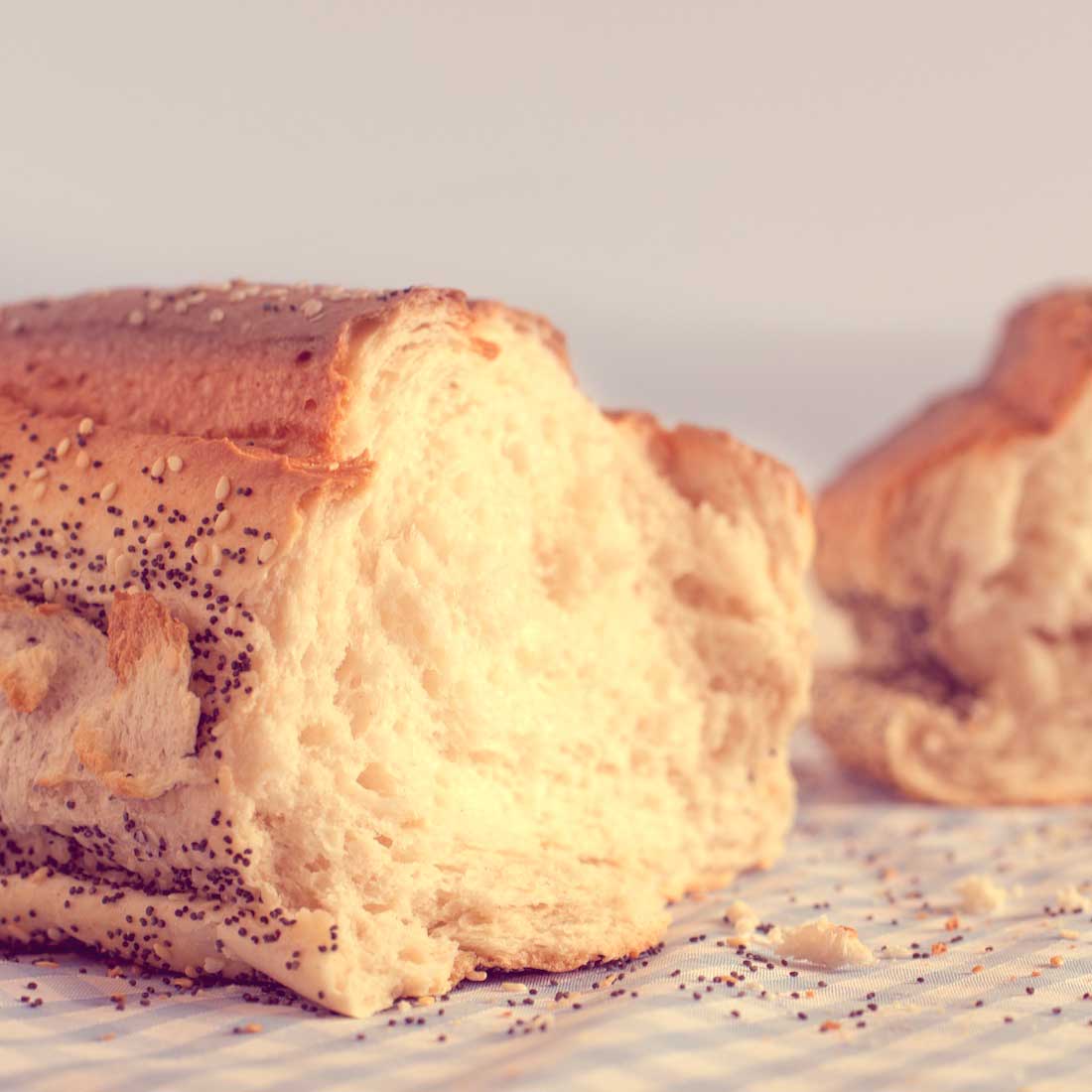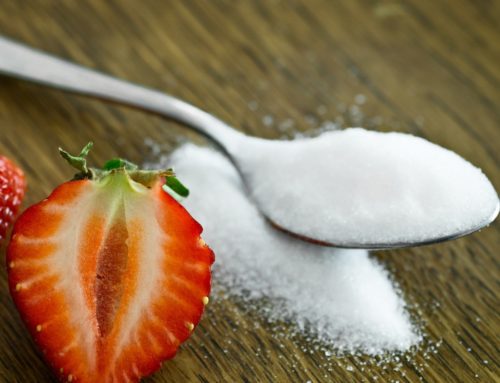We’ve all eaten it growing up and most of us crave it. White bread is everywhere but here’s the problem: it actually contributes to an entire range of chronic diseases.
What Exactly is the Difference Between White Bread and Whole-grain Bread?
To understand the problems with white bread, let’s look at the grain kernels that flour is made of. A grain kernel fresh off the plant has three layers. The outer layer is the bran which protects the inside portion of the grain and contains the bulk of the fibre in a grain kernel. At the very core of the grain kernel is the germ which contains other vitamins and minerals. White flour (and white bread) are mostly composed of endosperm, the middle layer of the grain kernel. All three layers together make a ‘whole grain’.
You get a lot less nutrients from white bread compared to whole-grain bread. How much less? A whopping 50% less fibre and potassium, 98% less magnesium, 75% less thiamin, 80% less niacin, and 80% less iron.
If White Bread is Bad For You, Why do Bakers Make it?
The reasons why we have white bread are more to do with storage than our health. In the 1800’s with the advent of steam-powered mills, white bread quickly became affordable. Bakers soon found that using white flour made baking easier. As a bonus, white flour could be stored longer and attracted less insects. For some people, white bread became a status symbol. White bread may be ubiquitous, but not because of its nutritional value.
Why is White Bread Unhealthy?
To understand the root of the problems with white bread, let’s look at how our bodies react to carbohydrates.
Glycemic Index 101
We didn’t use to know much about the glycemic index. A few decades ago, the common wisdom was that there were two types of carbohydrates: simple and complex. Simple sugars were carbs that had short chains of sugar molecules, such as table sugar made of two molecules. Complex carbs were foods like potatoes and any kind of bread, starchy foods made of long chains of simple sugars. The advice back then was to eat less simple carbs and stick to the complex carbs.
We’ve found now that this piece of advice is too simplistic. In reality, complex carbs are not all the same. Our bodies respond differently to the various types of complex carbs. The ‘glycemic index’ indicates how quickly our blood glucose increases after eating a food compared to eating white table sugar. Foods are rated from 0 to 100, with a lower number indicating a slower and smaller blood glucose increase. For example, the glycemic index of apples is 39. Gatorade rings in at a whopping 78 and a plain white baguette is rated at 95 . That means an apple raises your blood sugar less and slower than white bread and Gatorade. White bread is, without question, high-glycemic. Here’s a list of the glycemic index of 100 foods.
How Your Body Reacts
Here’s what happens when you have some white bread. First, your blood glucose levels shoot up as your body breaks down the white bread. The β-cells in your pancreas are triggered to action by the spiking blood glucose and work quickly to secrete insulin. High amounts of insulin are released and your blood glucose levels drop sharply.
Compare that to how your body responds to a low-glycemic meal. Instead of spikes in blood glucose and insulin levels, your body would only experience a gradual increase in blood glucose and the pancreatic cells wouldn’t have to work furiously to produce the insulin needed.
You still with me?
Here are the long-term effects of high-glycemic foods:
1. Your risk of diabetes increases
If the pancreas regularly works overtime to produce enough insulin, it starts failing. When the panreas can no longer produce enough insulin after each meal, your risk of irreversible type 2 diabetes increases. American foods commonly associated with diabetes are white bread, potatoes, and pop.
2. So does your risk of cardiovascular disease
We now know eating high-glycemic foods is connected with increased serum triglyceride and lower HDL (‘good’) cholesterol. Both are risk factors of cardiovascular disease.
3. Obesity
Our blood sugar levels are tightly linked to how much we feel like eating. If your blood sugar falls sharply, you’ll likely start munching. Let’s go back to what happens to your blood sugar level after a high-glycemic meal. First it shoots up, then plunges after the pancreas releases insulin. However, after a low-glycemic meal, that swing is reduced to a more moderate level. Most studies find that eating high-glycemic foods like white bread can lead to obesity. That large swing is likely the reason for it.
Here’s Your List of Healthy White Bread Substitutes
- Pass on the white toast and start off your day with a whole grain like steel-cut oats.
- Replace hamburger buns with sweet potatoes.
- Eat more legumes, whole grains, and some fruit. All of them contain more fibre which will help you feel full quicker.
- Wondering what’s the best bread for diabetics? Look for a 100% whole-grain bread.
Here’s How to Decipher Food Labels
Looks can be deceiving
Just because a bread product looks brown or has “wheat” in the label doesn’t guarantee the bread is loaded with nutrients. If the first ingredient on the package is “wheat flour” or “enriched bread flour”, put the bread back on the shelf.
Is multigrain bread the best choice for me?
“Multigrain” doesn’t necessarily mean “healthy”. All “multigrain” means is that the bread is made with a number of different grains. However, the nutritional value of a bread doesn’t depend on how many types of grains the bread contains but whether the grains are whole. Multigrain loaves can contain many types of grain stripped of bran and germ. Check for the label ‘100% whole grain’.
Only buy “100% whole wheat” or “100% whole grain” products
Expect food labels to be misleading. A bread package labelled “made with whole wheat” or “made with whole grains” likely means that white flour is the main ingredient with a small amount of whole grains tossed in. Look for the “100% whole wheat” or “100% whole grain” and don’t settle for anything less.
Here’s an important note. “100% whole wheat” mean different things in Canada and the U.S. In Canada, under the Food and Drug Regulations, “up to 5% of the kernel can be removed to help reduce rancidity and prolong the shelf life of whole wheat flour”. The removed portion of the kernel contains the bulk of the germ in a kernel. In the U.S., “100% whole wheat” products cannot have any portion of the kernel removed.
So what does this mean for Canadians? Bread would be more nutritious if the entire kernel were kept intact, but whole wheat is still the better option. Always look for 100% whole wheat bread.
Always check the nutrition label
Food labels are tricky. A product may be 100% whole grain, but still be loaded with sugar and fat.
Some breads and crackers don’t contain any white flour and can legally carry the label “100% whole grain”. Here’s the but: they may still contain high-fructose corn syrup, lots of oil, and an unhealthy dose of malt syrup. Not ingredients you were hoping for in a healthy breakfast. The next time you’re in a grocery store, take a look at the ingredient labels of some common bread and cracker products. You’ll be amazed at what’s in there.
The solution? Always check the ingredient label and ignore the marketing terms on the package. Make sure “100% whole grain” is the first ingredient and that sugars and fats are listed last.
Chew on this
Eating white bread is a habit for most of us. Unfortunately, white bread is also unhealthy. We’re used to the fluffy texture of white bread more than we are to the nutty flavour of whole-grain loaves. However, as with handling sweet foods with a sugar detox, my patients find that their preference for white bread also disappears. Their taste buds get used to the whole-grain flavour. There’s also a bonus: whole-grain bread helps you feel full for longer and reduces cravings. No more guilty looks at the Oreo jar. Live well and eat well.
What do you use for a healthy white bread substitutes? Did we miss something in our list? Let us know in the comments!





Thank you so much for sorting out the confusion around the different breads.
My husband over the last 2 years, has had chronic pain in all areas of his body affecting his joints. He is lean, swam for 40 minutes every day for exercise, but now, has not done any form of exercise in 2 years and constantly complains of his feet hurting, shoulders, etc. He has been to arthritic doctors, family doctors, acupuncturist, etc. but nothing seems to work. He has been on anti-inflammatory drugs and arthritic drugs to no avail. He is moody, depressed, and has limited energy. I find it hard to live with him at this point. He is 62 years old and has a physical job. Can you suggest any avenues that we have not yet been down? Thank you in advance for your help!
Hi Sally
I’m sorry to hear about how tough this is for both you and your husband. I have seen patients that end up in a similar viscous cycle of feeling terrible, getting sick, getting on drugs, feeling worse and then eating the wrong things as comfort or convenience foods. Please encourage him to try lifestyle and diet changes: start by eliminating all processed food, soda and added sugar, and cows dairy for 10 days. During that time drink mainly water as a beverage, eat mostly vegetables with a little fresh or frozen berries. Beans and lentils are good and fish for protein.
You might find this article helpful: https://heathertickmd.com/anti%C2%AD-inflammatory-diet/
Best wishes